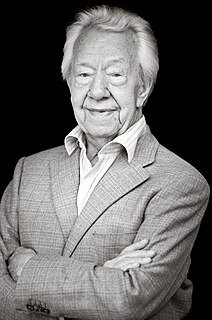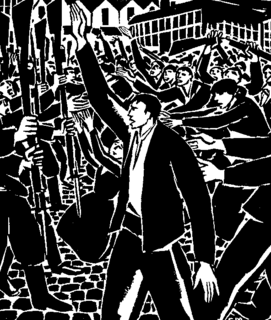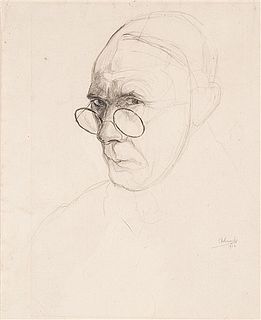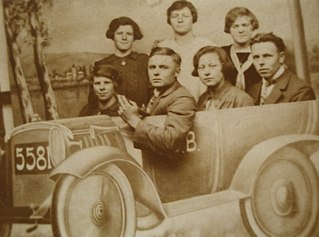
The Tour of Flanders, also known as De Ronde, is an annual road cycling race held in Belgium every spring. The most important cycling race in Flanders, it is part of the UCI World Tour and organized by Flanders Classics. Its nickname is Vlaanderens Mooiste. First held in 1913, the Tour of Flanders had its 100th edition in 2016.

Stijn Streuvels, born Franciscus (Frank) Petrus Maria Lateur, was a Belgian writer.

Marcel Honoree Nestor, Knight Neels, known as Marc Sleen, was a Belgian cartoonist. He was mostly known for his comic The Adventures of Nero and Co., but also created gag comics like Piet Fluwijn en Bolleke, De Lustige Kapoentjes, Doris Dobbel, Oktaaf Keunink and De Ronde van Frankrijk.

De Standaard is a Flemish daily newspaper published in Belgium by Mediahuis. It was traditionally a Christian-Democratic paper, associated with the Christian-Democratic and Flemish Party, and in opposition to the Socialist Flemish daily De Morgen. In recent years De Standaard has renounced its original ideological ties.

Frans Masereel was a Flemish painter and graphic artist who worked mainly in France, known especially for his woodcuts focused on political and social issues, such as war and capitalism. He completed over 40 wordless novels in his career, and among these, his greatest is generally said to be Passionate Journey.

Willy Vandersteen was a Belgian creator of comic books. In a career spanning 50 years, he created a large studio and published more than 1,000 comic albums in over 25 series, selling more than 200 million copies worldwide.

Het Nieuwsblad is a Flemish newspaper that mainly focusses on "a broad view" regarding politics, culture, economics, lifestyle, society and sports.
Maria, Baroness Rosseels, also known with her pen name "E. M. Vervliet", was a Belgian Catholic writer.
Philippe Goddin is a leading expert and literary critic of The Adventures of Tintin, and author of several books on Tintin and his creator, Hergé. He was general secretary of the Fondation Hergé from 1989 to 1999.

Merho, born Robert Merhottein on 24 October 1948, is a Belgian comic-book writer and artist, best known for creating the comic strip De Kiekeboes.
The Provinciale Zeeuwse Courant is a newspaper for the province of Zeeland, Netherlands published and owned by DPG Media of Belgium. Founded in 1758, it is the third-oldest newspaper of the Netherlands.
The Royal Academy of Fine Arts of Ghent, is one of the oldest art schools in Belgium. It is now part of the Hogeschool Gent.

Ecstasy: A Study of Happiness is a novel written by Louis Couperus and published in 1892 by L.J. Veen in a first edition of 1,250–1,500 copies. A second edition was printed in 1894 and a third in 1905. Ecstasy was the first book of Couperus that was published by L.J. Veen, later his regular publisher. Couperus received a wage of 550 guilders for the first edition. Ecstasy was first published in the Dutch literary magazine The Gids. The book was translated into English by Alexander Teixeira de Mattos in 1919 and published by Dodd, Mead and Company.

Passionate Journey, or My Book of Hours, is a wordless novel of 1919 by Flemish artist Frans Masereel. The story is told in 167 captionless prints, and is the longest and best-selling of the wordless novels Masereel made. It tells of the experiences of an early 20th-century everyman in a modern city.

25 Images of a Man's Passion, or The Passion of a Man is the first wordless novel by Flemish artist Frans Masereel (1889–1972), first published in 1918 under the French title 25 images de la passion d'un homme. The silent story is about a young working-class man who leads a revolt against his employer. The first of dozens of such works by Masereel, the book is considered to be the first wordless novel, a genre that saw its greatest popularity in Europe in the 1920s and 1930s. Masereel followed the book in 1919 with his best-known work, Passionate Journey.

SKEPP is an independent Belgian skeptical organization. The organization’s name is a backronym for Studiekring voor de Kritische Evaluatie van Pseudowetenschap en het Paranormale.

Jean-Jacques Dwelshauvers, who went by the name of Jacques Mesnil was a journalist, art critic, art historian and anarchist.
The City is a 1925 wordless novel by Flemish artist Frans Masereel. In 100 captionless woodcut prints Masereel looks at many facets of life in a big city.

Jules De Bruycker was a Belgian graphic artist, etcher, painter and draughtsman. He is considered one of the foremost Belgian graphic artists after James Ensor and achieved a high level of technical virtuosity. He is best known for his scenes of his home town Ghent, architectural views of cathedrals, war prints and book illustrations.

André Demedts was a Belgian Flemish writer and teacher. He has published works in many genres, all in Dutch. In 1962 he received the Prijs voor Letterkunde van de Vlaamse Provincies for his work De levenden en de doden. In 1976 he received the award in honour of his life-time career. In 1990 he has received the Award "Driejaarlijkse Staatsprijs voor literatuur" to honour his career as a writer. In 1970 the award André Demedtsprijs was established to reward persons engaged in the cause of the large Dutch/Flemish cultural development with a main purpose to integrate and entangle cultural activities in the Netherlands, Flanders and South Africa.